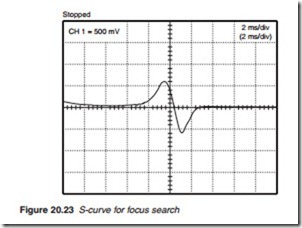Playback start-up routine
When the tray is closed, or when ‘playback’ is selected, a start-up routine is initiated. The purpose of the routine is to determine the size of the disc, whether it is a CD or a DVD/HD DVD (or BD) disc and whether it is a single- or a DL disc and carry out what is known as a ‘focus search’. The start-up routine will initiate the following steps:
● The spindle motor rotates the disk at a relatively high speed.
● The laser beam is directed onto the disc and the reflected beam is detected by the photodiodes to produce the RF signal.
● The sled motor moves the optical head across the disc from the centre towards the circumference and back again, to determine the diameter size and generate a TE signal.
● The two-axis actuator moves the objective lens up and down to obtain a focus, a process known as focus search.
CD/DVD detection
When the optical pickup head moves across the track, it generates a TE signal. If the TE voltage is low, then the inserted disk is a blue-laser disc; if it is high, it is a CD disc and in the middle, a DVD disc. Longer pits and wider track pitch produce a higher TE voltage.
Focus search
Once the type of disc is determined, focus search begins. At the beginning, the focus servo loop is kept open. The objective lens is moved up and down along an S-curve (Figure 20.23) crossing the full focus point. As it goes towards focus, the RF signal strength increases. When it reaches a specified threshold, determined by the type of the disc, a Focus OK (FOK) control line goes High and remains High. While the focus crosses the full focus (zero) line, the RF signal strength simultaneously goes to its maxi- mum value and begins to fall again. At this moment, the servo loop is turned on and a focus is established.
Single/dual-layer detection
The difference between a single and a DL disc is the intensity of the reflected laser beam. A single-layer disc is 100% reflective while the first layer (layer 0) of a DL disc is only partially reflective. This is identified by
what is known as the pull-in (PI) signal. The PI signal is obtained during the process of the focus search. A high PI signal indicates a highly reflective surface and thus a single-layer disc. Alternatively, a low PI indicates a DL DVD disc.
